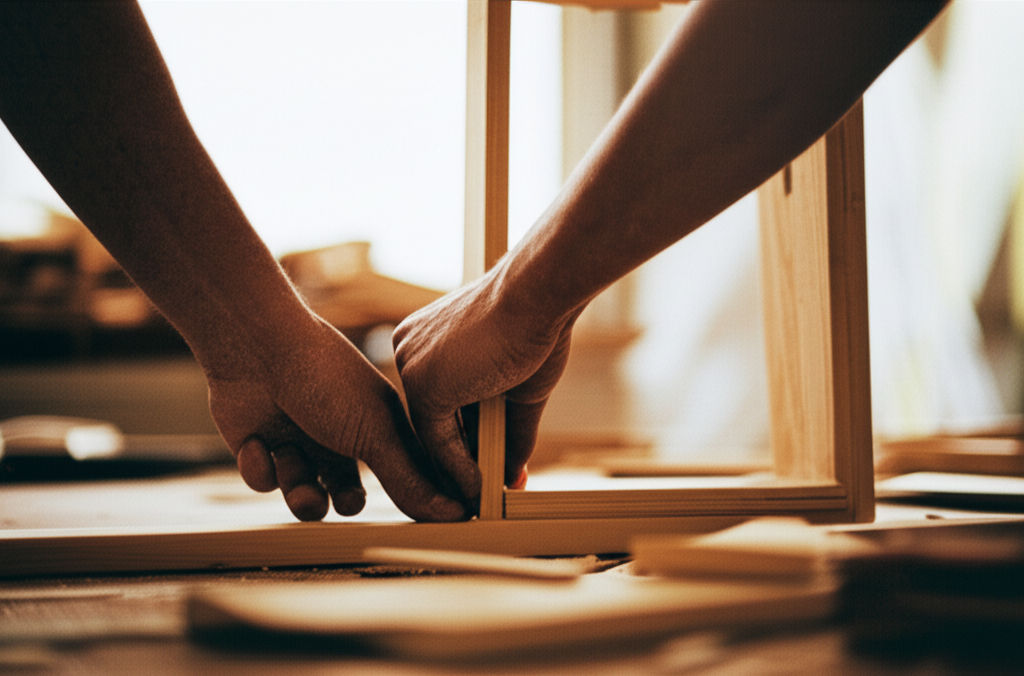Why Economy Lumber Is Budget Friendly
Ikhsan Rizki

Photo: Unlock budget-friendly building! Discover how economy lumber offers an affordable, quality solution for your projects without compromising integrity.
Navigating the world of home improvement or construction projects often leads to a common challenge: managing costs. Materials, especially lumber, can quickly inflate a budget. But what if there was a smart, cost-effective solution readily available? Enter economy lumber – a game-changer for budget-conscious builders and DIY enthusiasts alike.
This comprehensive guide will explain exactly why economy lumber is budget friendly, what it is, where it shines, and how you can wisely incorporate it into your next project without compromising on essential quality.
What Exactly Is "Economy Lumber"?
When you hear "economy lumber," your first thought might be "low quality" or "unusable scraps." However, this isn't necessarily the case. Economy lumber refers to the lowest grade of lumber, primarily chosen for its affordability. It's wood that has natural imperfections like knots, minor splits, slight warping, or wane (the presence of bark or an unplaned edge on a sawn piece of timber).
These characteristics, while making it unsuitable for projects requiring a pristine, flawless appearance, often do not compromise its structural integrity for many applications. For instance, SPF (Spruce-Pine-Fir) economy grade lumber, a common type, is known for its strength and durability despite its imperfections, maintaining the structural integrity needed for various construction uses.
The Core Reasons Why Economy Lumber Is Budget Friendly
The primary appeal of economy lumber lies in its price point. But what makes it so much more affordable than its higher-grade counterparts?
1. Grading Standards and Appearance
Lumber is graded based on its appearance and structural integrity. Higher grades, often labeled "Select" or "No. 1," have fewer knots, blemishes, and defects, making them ideal for visible applications like fine furniture or trim work. Economy lumber, on the other hand, falls into lower common grades (like No. 4 or No. 5 for softwoods, or 3A/3B Common for hardwoods). These grades permit more imperfections, which means less processing and sorting time, directly translating to lower costs.
2. Less Visual Perfection Required
Since economy lumber is intended for projects where aesthetics aren't the primary concern, manufacturers don't need to spend as much time and effort on its visual perfection. This reduction in labor and selective cutting contributes significantly to its budget-friendly nature.
3. Abundant Availability
Often, economy lumber consists of pieces from common, fast-growing tree species like spruce, pine, and fir. Their abundance and rapid growth cycles make them more readily available, which helps keep prices competitive.
4. Efficient Resource Utilization
Using economy-grade lumber also reflects efficient use of the timber resource. Instead of discarding wood with minor defects, it's utilized for purposes where those imperfections don't matter, reducing waste and contributing to a more sustainable building practice.
Where Economy Lumber Shines: Ideal Projects
So, where can you effectively use this cost-effective material? Economy lumber is incredibly versatile, particularly for applications where it won't be seen or where a rustic, character-filled look is desired.
- Framing and Structural Components: For the skeleton of a structure – be it a house, shed, barn, or even commercial construction – economy-grade lumber like SPF can provide the necessary strength and support without the need for a perfect finish.
- Subflooring and Sheathing: These are hidden layers beneath your finished floor or siding. Since they won't be visible, using economy lumber or related products like OSB (Oriented Strand Board) is a smart way to save.
- Temporary Structures: Building a temporary workbench, sawhorse, or formwork for concrete? Economy lumber is the perfect candidate.
- Utility Shelving and Storage: Need to build shelving in a garage, basement, or utility room? The imperfections of economy lumber won't detract from its function here, and you'll save a bundle.
- DIY Furniture Frames: If you're building a piece of upholstered furniture or a table where the frame will be covered or painted, economy lumber can be an excellent choice for the internal structure.
- Feature Walls (Rustic Look): For those embracing a rustic or industrial aesthetic, the knots and character of economy lumber can be highlighted to create unique feature walls or decorative accents.
- Outdoor Projects (with treatment): While raw economy lumber isn't ideal for direct exposure to the elements, it can be used for outdoor projects if properly primed, painted, sealed, or stained. For ground contact or high moisture, pressure-treated lumber is recommended, which is often a treated form of common or economy-grade wood.
Maximizing Your Savings: Tips for Buying and Using Economy Lumber
To truly leverage the budget-friendly benefits of economy lumber, consider these practical tips:
- Inspect Before You Buy: This is crucial. While imperfections are expected, you still want usable pieces. Look for excessive bowing, twisting, or large, loose knots that might compromise the board's integrity for your specific project. Hold the board up and look down its length to check for straightness.
- Understand Nominal vs. Actual Size: Lumber is sold by nominal dimensions (e.g., 2x4), but the actual size is smaller due to milling and drying. Always know the actual dimensions your project requires.
- Buy from Lumber Yards: Often, dedicated lumber yards offer better prices, a wider selection, and more knowledgeable staff than general retailers. They can guide you to the right economy-grade options for your needs.
- Plan Your Cuts: Due to knots or other defects, you might need to cut around certain areas. Plan your cuts carefully to minimize waste and ensure you get the most usable material from each board.
- Consider the Finish: If appearance matters, remember that economy lumber may not take paint or stain as smoothly as higher grades, especially if it has large knots or sap pockets. Factor this into your finishing plans.
- Embrace the Character: For visible projects, embrace the natural character of economy lumber. Knots and grain patterns can add unique charm and tell a story, making your project truly one-of-a-kind.
Beyond the Price Tag: Understanding the Trade-offs
While economy lumber is undeniably budget friendly, it's important to be realistic about its limitations. It's not the right choice for every project. For fine woodworking, exposed cabinetry, or structural elements requiring strict aesthetic uniformity and minimal defects, investing in higher-grade lumber is often necessary. The goal isn't to use economy lumber everywhere, but to use it strategically to save money where its characteristics are either irrelevant or even desirable.
Conclusion
Economy lumber offers a compelling solution for anyone looking to undertake construction or DIY projects on a budget. By understanding what it is, its inherent characteristics, and its ideal applications, you can significantly reduce material costs without sacrificing the functionality or structural soundness of your work. It's about making smart, informed choices that align with your project's needs and your financial goals.
Are you ready to explore the possibilities of economy lumber for your next project? Share your thoughts or ask questions in the comments below, or check out our other articles on cost-effective building materials!
Frequently Asked Questions
Q1: Is economy lumber always low quality?
A1: Not necessarily "low quality" in terms of structural integrity, but it is the lowest grade of lumber based on appearance. It will have more natural imperfections like knots, splits, and wane compared to higher grades. For many non-visible or utilitarian applications, these imperfections do not affect performance.
Q2: Can I use economy lumber for outdoor projects?
A2: Yes, economy lumber can be used for outdoor projects, but it requires proper treatment and sealing. For applications where the wood will be exposed to moisture or direct ground contact, pressure-treated lumber (often a form of economy or common grade wood) is highly recommended for durability and resistance to rot and insects.
Q3: What's the main difference between economy and standard lumber?
A3: The main difference lies in the number and size of defects. "Economy" (like No. 4 or No. 5 softwood) has the most defects, including large knots, splits, and wane. "Standard" (like No. 2 softwood) has fewer and smaller defects than economy grade, making it suitable for general construction where some imperfections are acceptable but appearance isn't completely disregarded.
Q4: How can I identify economy lumber at the store?
A4: Economy lumber is typically marked with grade stamps (e.g., "No. 4 Common," "No. 5 Common," or "Economy"). Visually, you'll notice more knots (some potentially loose or with holes), splits, cracks, and sometimes a less uniform shape or "wane" (where the edge of the board still has the rounded profile of the tree trunk). Always inspect each board for straightness and usability before purchasing.
Business
View All
November 14, 2025
What LLC UIC Means for Your Business"LLC UIC" demystified! Learn what business ID numbers (like EIN) truly matter for your LLC's compliance and smooth operation.
Ikhsan Rizki

October 25, 2025
RI Business Search Made EasyMake your RI business search easy! This comprehensive guide helps you quickly find any Rhode Island business information you need.
Ikhsan Rizki

October 31, 2025
Shirt Size Chart for Business WearMaster your professional image! Our guide decodes shirt size charts for business wear, ensuring a perfect fit and boosting your confidence.
Ikhsan Rizki

August 29, 2025
What to Know About Car Wash BusinessesLaunch a profitable car wash! Your ultimate guide to business models, startup costs, operations, and marketing strategies for success.
Ikhsan Rizki

October 19, 2025
Tips for Successful Business MeetingsTired of pointless meetings? Discover practical tips to transform your business gatherings into productive, results-driven sessions.
Ikhsan Rizki

August 27, 2025
Healthcare Business Management PayCurious about Healthcare Business Management pay? Explore salary ranges, key factors, and how to increase your earning potential in this vital field.
Ikhsan Rizki
Economy
View AllElevate your content with stunning visuals! Discover where to get free economy clipart to enhance presentations, marketing, and blogs, even on a tight budget.
Ikhsan Rizki
Honda Civic Type R MPG: Get the surprising truth about its fuel economy. Performance meets practicality. Learn real-world facts!
Ikhsan Rizki
Discover The Economy Shop Oak Park: a century-old non-profit thrift store fueling local charities & sustainability. Shop smart, do good!
Ikhsan Rizki
Is the US economy still the world's envy? Explore its enduring strengths and emerging challenges in this balanced look at America's economic standing.
Ikhsan Rizki
Considering British Airways 787 Premium Economy? This guide unveils enhanced comfort, more space, & great value for long-haul flights on the Dreamliner.
Ikhsan Rizki
Your ultimate guide to Honda CR-V fuel efficiency. Explore MPG for gas & hybrid models, 2025 ratings, and tips to maximize savings at the pump.
Ikhsan Rizki
Education
View AllUnravel the Best State for Education Rankings! Understand the key metrics for K-12 & higher ed quality to make informed choices for your family's future.
Read MoreDiscover New Haven adult education programs! Achieve career goals, earn your GED, improve English, or gain vocational skills. Flexible & supportive pathways awa...
Read MoreUnlock potential with Universalisation of Elementary Education (UEE). Discover its meaning, vital importance, and global efforts to ensure quality education for...
Read MoreNurses: Discover remote patient education jobs! Empower patients from home, achieve work-life balance, and leverage your expertise. Your guide to this evolving...
Read MoreDiscovering Wellness and Adventure: Inside the Arrillaga Outdoor Education Center Are you seeking a place where personal growth meets thrilling adventure? Do yo...
Read MoreDiscover Educators Rising! Learn how this national organization empowers middle & high school students to become the next generation of impactful educators.
Read MoreHealth
View All
September 2, 2025
Top Health Info Management JobsUnlock your future! Explore top Health Information Management (HIM) jobs in this growing field. Combine healthcare, tech & business, no direct patient care.
Ikhsan Rizki

September 25, 2025
Sanford Health Is Hiring NowSanford Health is hiring! Discover a rewarding career making a difference in healthcare. Explore diverse roles, strong values, and growth opportunities.
Ikhsan Rizki

September 1, 2025
Gold Coast Health Plan OverviewNavigating healthcare in Ventura County? Discover Gold Coast Health Plan (GCHP) for Medi-Cal eligibility & comprehensive, affordable benefits.
Ikhsan Rizki

September 30, 2025
Start Your Ballad Health CareerDiscover a rewarding healthcare career at Ballad Health in the Appalachian Highlands. Explore diverse roles & how to apply.
Ikhsan Rizki

November 17, 2025
Use M Health MyChart TodayM Health MyChart simplifies your healthcare. Access records, message doctors, schedule appointments, and manage bills securely online. Take control of your heal...
Ikhsan Rizki

October 6, 2025
Why Choose Zufall Health CenterChoose Zufall Health Center for comprehensive, accessible, and affordable healthcare in New Jersey. Your trusted partner for patient-centered care.
Ikhsan Rizki
Popular Articles
View All
1
2
3
4
5
6
7
8
9
10
Lifestyle
View All
October 11, 2025
Dick’s Baseball Style Gear
Elevate your baseball game! Discover quality bats, gloves & essential gear at Dick's Sporting Goods – your one-stop shop for every player.

September 28, 2025
Rockstar Lifestyle Lyrics Explained
Unpack the "rockstar lifestyle" in music lyrics. Explore themes of wealth, parties, fame, and rebellion, plus their deeper meanings.

August 29, 2025
Healthy Lifestyle Clipart Ideas
Struggling with bland health content? Discover how healthy lifestyle clipart can elevate your wellness messages, making them engaging and inspiring!

September 28, 2025
Choosing the Right Condom Size
Don't guess your condom size! A proper fit is vital for safety, pleasure & preventing breakage. Learn how to measure correctly & choose the right condom for you...

November 13, 2025
Meet the team behind lifestyle staff
Meet the passionate experts behind our lifestyle content. Learn how their expertise & authenticity deliver trustworthy guides for a better life.

August 23, 2025
Life at Arborwood Preserve Today
Discover Arborwood Preserve: Fort Myers' resort-style community with luxury homes, vibrant activities & unmatched amenities. Live your dream life!

September 25, 2025
Puma Park Lifestyle Sneakers Drop
Elevate your style with Puma Park Lifestyle Sneakers! Discover urban cool, comfort, and versatile design. Your must-have for daily grind & weekend adventures.

October 8, 2025
Bose Model 5 Music System
Explore the Bose Model 5 Music System. Get immersive, room-filling sound from a sleek, compact home audio solution. Rediscover your music!
Sports





Travel
View All
August 31, 2025
Kors Jet Set Travel Bags Review
Planning your next trip? Explore our review of Michael Kors Jet Set travel bags, blending style, durability, & organization for your ultimate journey.

October 6, 2025
Best Men’s Travel Pants for Any Destination
Find your perfect men's travel pants! Our guide helps you choose comfortable, stylish, and versatile trousers for any destination. Travel smarter.

November 25, 2025
Florida Travel Packages Affordable
Unlock affordable Florida travel! This guide reveals how to find budget-friendly packages for beaches, parks & more, making your dream trip a reality.

November 10, 2025
Traveling Medical Assistant Jobs Guide
Medical Assistants: Explore the exciting world of Traveling MA jobs! Combine healthcare skills with wanderlust for a dynamic, flexible, and rewarding career.

September 19, 2025
2 Bedroom Travel Trailers
Unlock ultimate comfort & space on the road! Discover 2 bedroom travel trailers, perfect for families & groups seeking privacy & enhanced adventures.

August 13, 2025
How far bullets can travel
Unravel the science of ballistics! Discover how far bullets really travel, influenced by gravity, drag, and wind. Beyond straight lines, learn the truth.

















